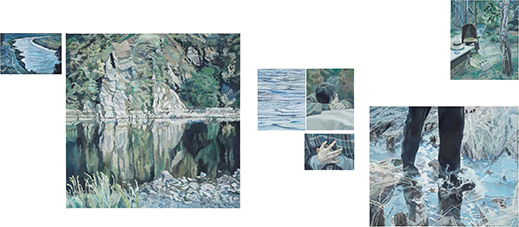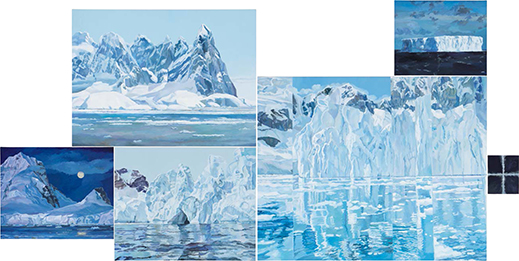 |
|
Here and There introduces art, artists, galleries and museums around Japan that non-Japanese readers and first-time visitors may find of particular interest. The writer claims no art expertise, just a subjective viewpoint acquired over many years' residence in Japan.
|
|
 |
|
|
 |
 |
Asuka Takamatsu: Subconscious Narratives at the Mitaka City Gallery
Alan Gleason |
 |
|
Oneself Reflected Many Times (2017) |
I like my local museum, which modestly calls itself a gallery. Opened in 1993, the Mitaka City Gallery of Art occupies the fifth floor of a building next to Mitaka Station, one of the first suburban stops as you head west from Tokyo on a major commuter line. Curator Yuki Otake explains that while the floor space is too small to call the facility a museum, the staff manages to accommodate substantial exhibitions by erecting temporary partitions that divide the gallery into a series of corridors. The only drawback, Otake says, is that the corridors are too narrow for stepping back to see large works from a distance. Still, it's one of the most efficient uses of limited exhibit space I have seen anywhere.
|
Exhibition view, The Unreachable Place, Mitaka City Gallery of Art, 2017 |
As a city-owned facility, the gallery also deals with temporal constraints. Allotted time for only two full-scale exhibitions a year, it is otherwise mandated to rent its rooms out for local shows. But those two annual exhibitions are of consistently stellar quality, benefiting no doubt from the long preparation periods this restricted schedule affords. Otake mentions that one upside of the small number of major shows is that the gallery never runs out of ideas -- indeed, they have a frustratingly large backlog of artists they'd like to exhibit.
Though the gallery does not confine itself to any particular genre or era of art, thanks to Mitaka's history as a mecca for creative types in the immediate postwar era (housing was cheaper than downtown) there is a pronounced leaning toward modern and contemporary artists, particularly of the sixties and seventies. The city's most prominent resident artist may be Jiro Takamatsu (1936-98), co-founder of the legendary avant-garde group Hi Red Center, whose influence can be felt in many of the gallery's contemporary retrospectives.
 |
|
Crossing the River (2017) |
The current exhibition manifests the gallery's virtues in spades. The Unreachable Place is the first large solo outing by Asuka Takamatsu (no relation to Jiro), a painter of undeniable talent and promise just beginning to enjoy national recognition. Not a local artist, she hails from the city of Takamatsu (another name coincidence) on the Seto Inland Sea hundreds of miles southwest of Tokyo, and most of her shows to date have been in her home region. Why now, in Mitaka? Otake says it was serendipity: the gallery's chief curator, Yuichiro Asakura, happened to see Takamatsu's work in a group show in her hometown, and became a fan. The fruits of this fortuitous encounter are on display at the Mitaka City Gallery until 22 October.
 |
At first sight, Takamatsu's work does not appear startlingly original. Her m.o. is painting reproductions, in acrylic on canvas, of scenes she culls mostly from movies, magazines, or the Web. Her brushwork is impeccable, with a touch just loose enough to add an impressionistic fluidity to the images for an effect somewhere along the spectrum between photorealism and abstraction. Several other techniques also come into play that distance her works from the pictures they are based on, and give them a coherency that draws the viewer into a world very much the artist's own. One is a compositional trick of trimming down to details -- a hand, the back of a head -- that deprive the viewer of any context; hence there is no way to identify the original source of the image. She also employs a palette skewed toward blues and grays, a preference she attributes to growing up by the sea. Blue-gray tones predominate in nearly all her work but are especially effective in her paintings of glaciers and seascapes.
 |
In recent years, Takamatsu has expanded the notion of composition beyond individual paintings to their collective display in her exhibitions. The impact of her Mitaka show, in fact, derives less from that of each painting than from the grouping of the works on the walls. Takamatsu has arranged 160 of her paintings (created over a period of several years, from 2009 to the present) in 27 groups of a half dozen or so each. Sometimes there is an obvious common motif -- the glaciers in Blue Shine, reflections in Oneself Reflected Many Times, figures with their backs to the viewer in Someone Who Finally Turned in Our Direction -- but most of these juxtapositions have no overt thematic link, and that is evidently as the artist intends it. The ordering impulse of the mind kicks in, and the viewer can't help but try to come up with some sort of narrative. It's quite fun, despite (or due to) our awareness that the storytelling is a product of our own imagination. Takamatsu takes pains to ensure that whatever story may lurk behind these sequences remains obscure. But because of the care with which she paints each work, none of the images seem frivolous, and their aggregate effect never fails to inspire a range of emotions, often soothing and disturbing us at the same time.
 |
|
Someone Who Finally Turned in Our Direction (2017) |
Takamatsu explains that she arranged the works for the current show at the behest of the curator, moving small photocopies of her paintings around on her desk in jigsaw-puzzle fashion till she found a grouping she liked. In the process, which she describes as arduous, she discovered resonances among her works that she had never noticed before. Thus each series on the gallery wall is a product of spontaneous self-discovery, not thematic planning. Takamatsu reinforces the conceit that every group of paintings is itself a new composition by appending a new title to each set and dating all of them "2017" -- the year she assembled them together for this show. Only by perusing the catalogue can one learn the original titles and dates of the individual works. Though labeling every single painting would certainly clutter the display, it's unfortunate that this information is so difficult to access.
|
Exhibition view, The Unreachable Place, Mitaka City Gallery of Art, 2017 |
Complementing the innovative and thought-provoking layout of the show are not only its thoroughgoing catalogue, which is in both Japanese and English, but also an impressive range of merchandise (totebags, calendars) attractively showcasing Takamatsu's work. All of this added value was prepared by the Mitaka City Gallery, testimony to the facility's commitment to its artists as well as its knack for marketing.
|
Having Impressions of Birds (2017) |
It is hard to explain the cumulative power of Takamatsu's work, but it is clearly more than the sum of its parts. Somehow, the archetypal quality of her found images, the painterly techniques through which she transforms them into a personal language, and the ambiguous hints at narrative in her arrays of paintings all conspire to rouse strong and complex emotions in the viewer. One senses in Takamatsu a deep vein of subconscious sensibilities that she has only begun to tap.
All works by Asuka Takamatsu, photographs courtesy of the Mitaka City Gallery of Art. |
 |
| The Unreachable Place -- Takamatsu Asuka Exhibition |
| 11 August - 22 October 2017 |
| Mitaka City Gallery of Art |
5th floor, Coral Bldg., 3-35-1 Shimo-Renjaku, Mitaka, Tokyo
Phone: 0422-79-0033
Hours: 10 a.m. to 8 p.m. (last entry at 7:30 p.m.)
Closed Mondays (except open 9 October and closed 10 October)
Access: Directly across from the south exit of Mitaka Station on the JR Chuo Line (20 minutes west of Shinjuku, Tokyo) |
|
|
|
| |
 |
Alan Gleason
Alan Gleason is a translator, editor and writer based in Tokyo, where he has lived for 30 years. In addition to writing about the Japanese art scene he has edited and translated works on Japanese theater (from kabuki to the avant-garde) and music (both traditional and contemporary). |
|
|
|
|
|
|
|
|
|
 |
|